- Reflation trade evident in US and Europe markets
- Investors shrug off China’s first PMI contraction in 18 months
- Bitcoin ended its decline
- FOMC member, Jerome Bostic is speaking today and on Thursday.
- On Thursday US initial jobless claims are released.
- PMI figures for the UK are released on Friday.
- THe FTSE 100 gained 0.9%
- The STOXX Europe 600 rose almost 0.9%
- Futures on the S&P 500 added almost 0.4%
- Futures on the NASDAQ 100 climbed less than 0.2%
- Futures on the Dow Jones Industrial Average gained almost 0.4%
- The British pound gained almost 0.1%
- The Dollar Index was little changed
- The euro was up almost 0.1%
- The Japanese yen rose 0.3%
- Britain's 10-Year yield advanced one basis point
- The yield on 10-year Treasuries gained one basis point
- Germany’s 10-year yield advanced one basis point
- Brent crude rose 0.4%
- Spot gold fell 0.25%
Key Events
Global stocks and US futures on the Dow, S&P, NASDAQ and Russell 2000 advance on the first day of September, as investors ignored economic figures signalling weakness. Despite negative headlines, traders are buying into the repeated Fed promise that the sharpest inflation spike since before the 2008 crash is only temporary and will abate once bottlenecks in the supply chain clear.
Treasury yields recovered.
Global Financial Affairs
Positive earnings and a strong macro picture mean investors are now enjoying more than a run-of-the mill Goldilocks economy—meaning it's neither running too hot nor too cold—as it is also being continuously stimulated by global central banks. As a result, all four US contracts were trading in the green on Wednesday, ahead of the US session.
The message being signalled via different index-futures is the reflation trade is back in play as contracts on the Russell 2000 were up the most, while those on the NASDAQ 100 lagged. This strong opening—driven by by cyclicals—follows a month in which stocks posted 12 record closes.
Shares in Europe also opened higher as a surge in the Asian session created momentum.
The STOXX 600 Index extended gains—after its seventh straight month of gains which is the first time the benchmark has had such a run since 2013—as it crawls back to its mid-August all-time high. The pan-European gauge rose with travel firms and retailers, which benefit from economic reopening, mirroring the performance in US futures.
After yesterday’s flat open and lower close in UK markets—as traders did not appear to want to catch up with fresh records hit Monday on Wall Street—the FTSE 100 climbed boosted by UK retail prices which rose 0.4% monthly according to the British Retail Consortium, with the outlook that rising demand for shipping and raw materials will keep prices rising into Christmas.
Stocks in Asia rebounded from earlier declines this morning which were provoked by data demonstrating that factory activity lost momentum in August, as the ongoing pandemic upset supply chains. Investors ran up stocks, even after China’s Purchasing Manager’s Index pointed at a contraction in activity for the first time in almost 18 months, a result of the infamous supply bottlenecks created by the Delta strain of coronavirus.
Moreover, China’s zero tolerance policy on the virus will probably keep supply chains disrupted, as the country implements lockdowns on any outbreak, however small. MSCI’s broadest index of Asia-Pacific stocks excluding Japan still turned positive, gaining 0.2% to the highest level since early last month, after climbing for six of the last seven days.
China’s Shanghai Composite gained 0.7% despite weakening growth, and Japan’s Nikkei 225 rose 1.3%, outperforming the region. Paper & Pulp, Railway & Bus and Real Estate sectors led the rally.
Investors released their firm grip on Treasuries, allowing yields on the 10-year note to jump back above 1.3%.
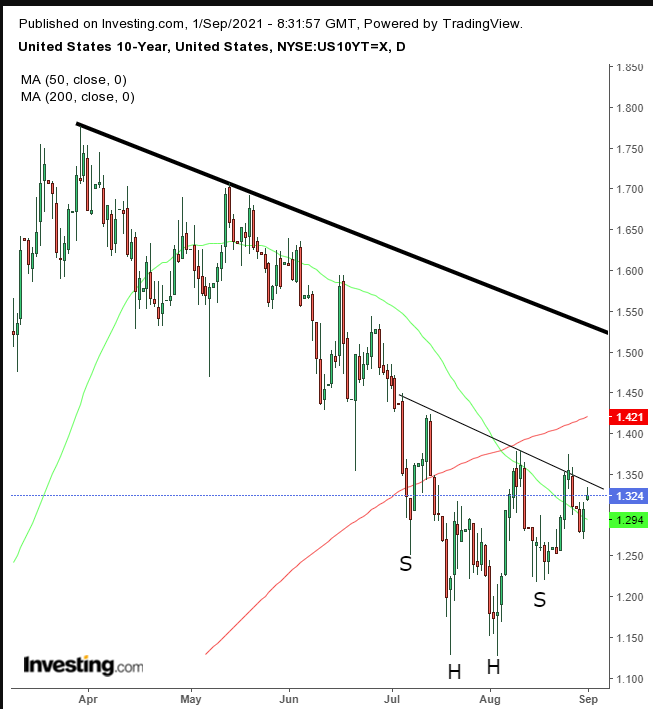
While returning to the upper levels of their trading for the last two months, yields pared gains, having found resistance by the neckline of a potential H&S bottom, whose possible bearish dynamics for Treasuries is going head-to-head with the downtrend in yields, succinctly encapsulated by the recent Death Cross.
The dollar struggled to rise from its near-three week low, demonstrating the market’s outlook ahead of a potentially catalytic US employment report on Friday, after Federal Reserve Chair Jerome Powell said that paring stimulus depends on an improving jobs market.
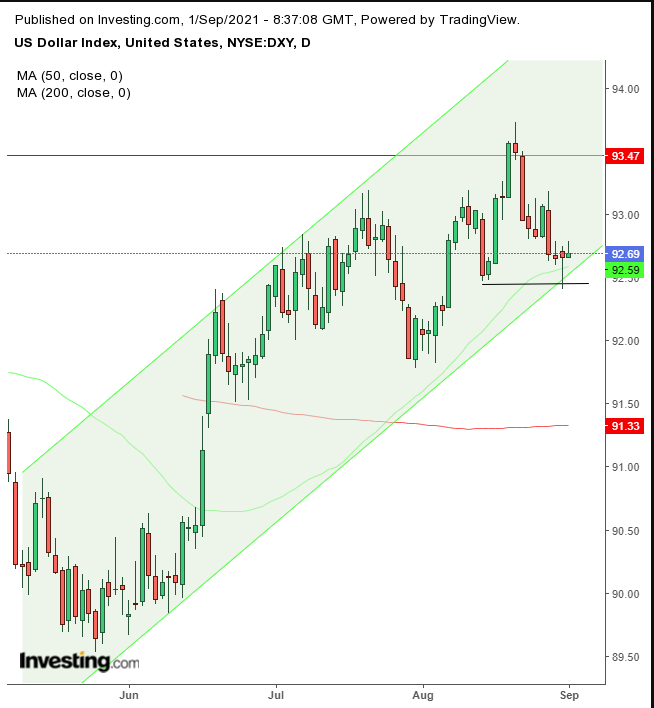
Traders find themselves in a precarious position—also the best kind for aggressive traders, who seek sharp moves—as the greenback is squeezed between the neckline (red) of a massive double-bottom and a small H&S top. The neckline tests the bottom of its rising channel and is reinforced by the 50 DMA after it crossed above the 200 DMA, triggering a Golden Cross.
Gold demonstrated the same conflict, as it moves in a mirror-image of its base currency.
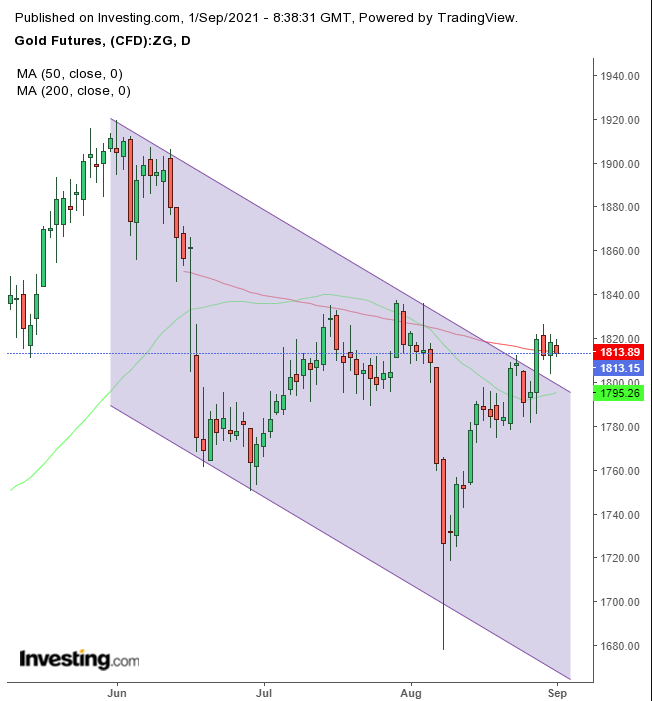
The price was struggling between the 200 DMA—after a Death Cross—and breaking free of its falling channel.
Bitcoin kept trading within a potential falling flag, bullish after the preceding two-day jump.
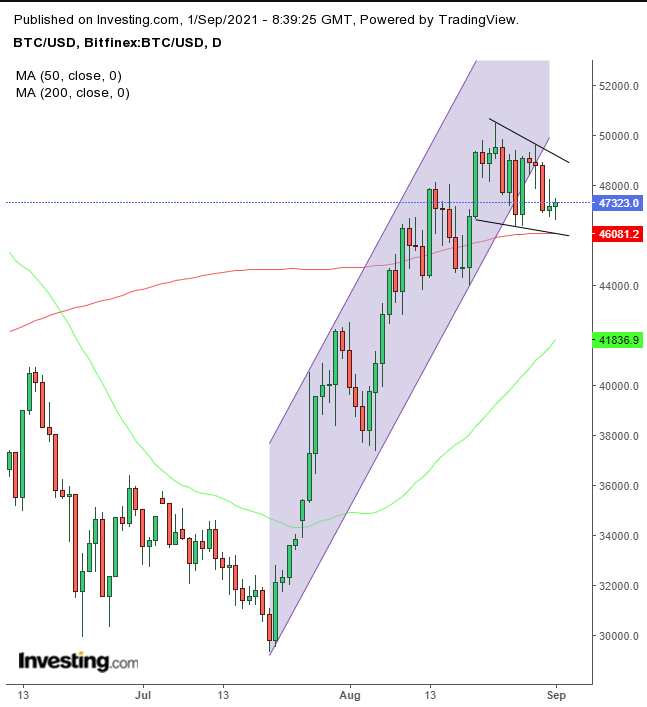
The cryptocurrency's 200 DMA supports the continuation pattern.
WTI climbed above $69 before this month's OPEC+ meeting that is slated to confirm a rise in production.
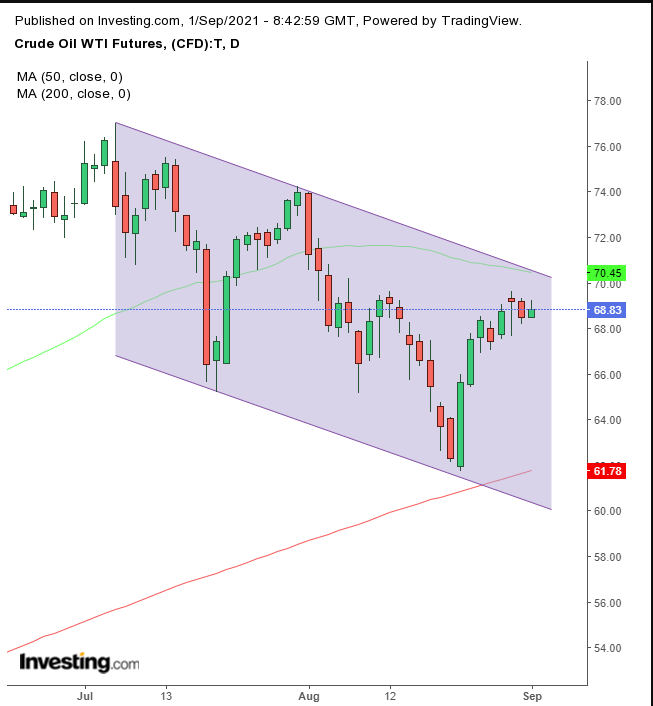
The price trimmed earlier gains, finding resistance by recent highs, below the top of the falling channel—even though yesterday’s decline was not significant enough to complete an Evening Star.
